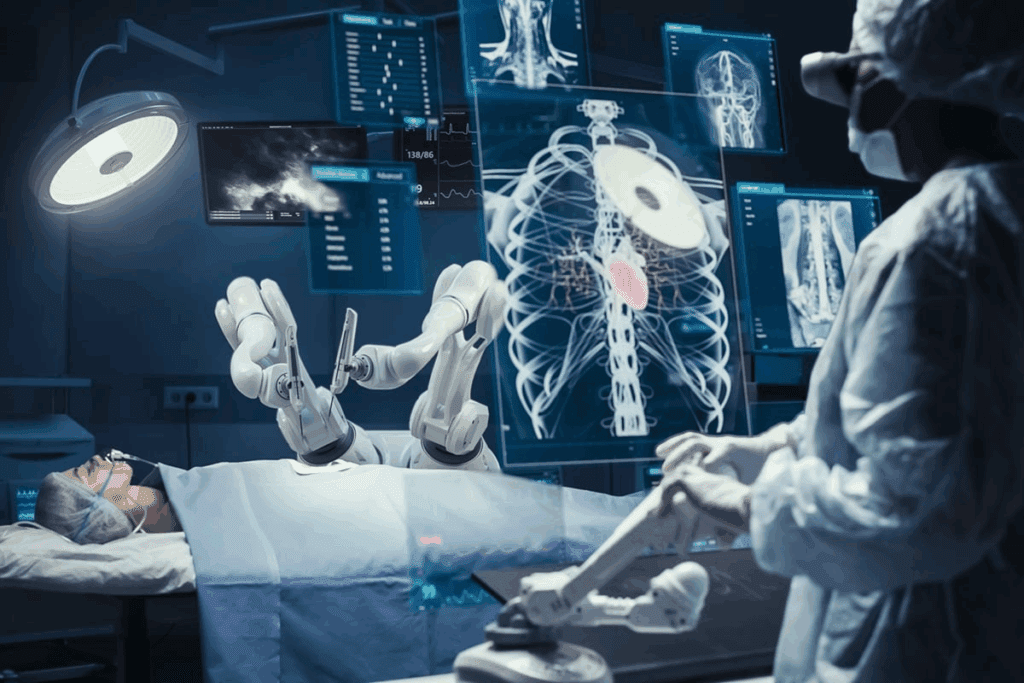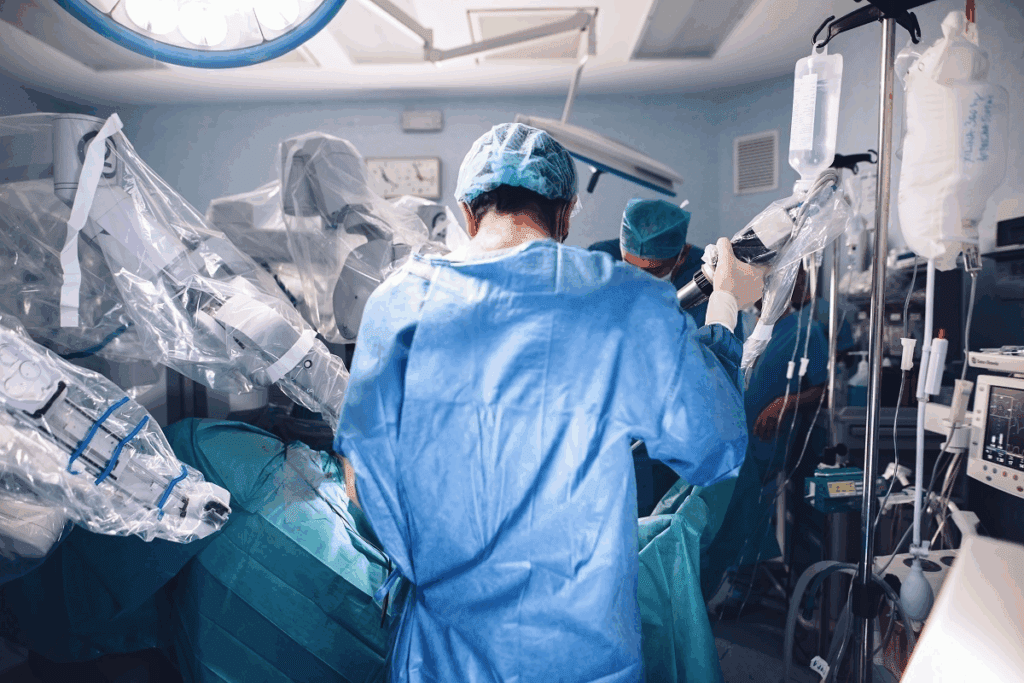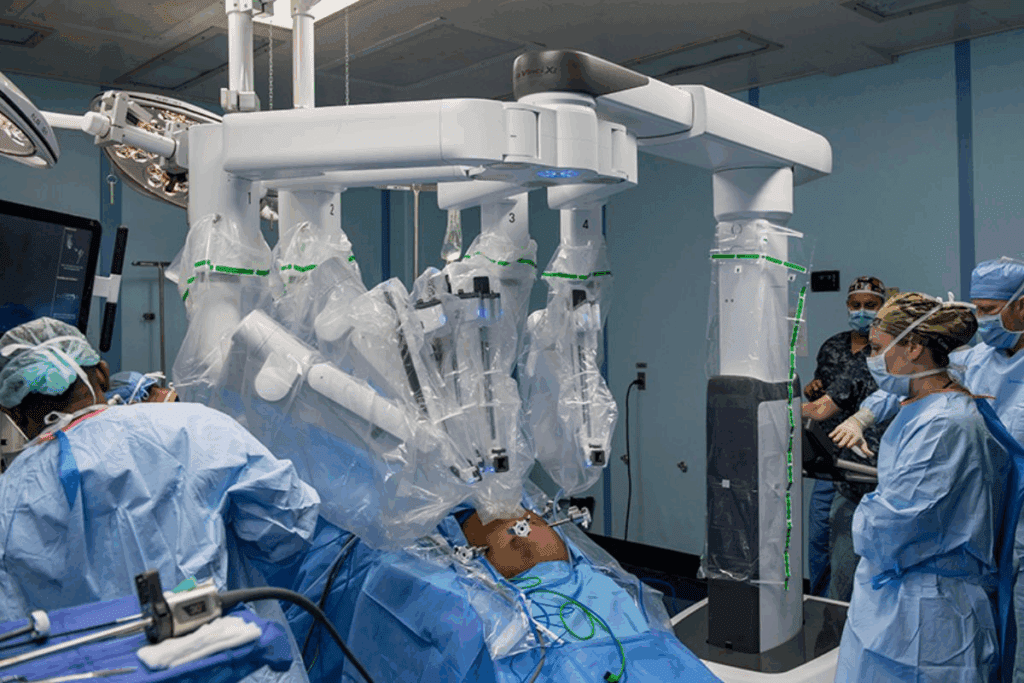Last Updated on November 27, 2025 by Bilal Hasdemir

Robotic heart surgery is changing the medical world. It’s a new way to fix heart problems without the big cuts of old-school surgery. With robotic surgery, a doctor uses robotic arms to do the work. This means less pain and a quicker recovery.
But, not everyone can have this surgery. Doctors look at the heart problem, your overall health, and past surgeries to decide. These things help figure out if you’re right for robotic heart surgery.
Your doctor will talk to you about robotic cardiac surgery. They’ll look at the good and bad sides to see if it’s right for you.
Robotic heart surgery is a big step forward in heart care. It offers a less invasive option compared to traditional open-heart surgery. This new technology has changed cardiology, making complex surgeries more precise and accurate.
Robotic heart surgery uses a robotic system to help surgeons during heart operations. The robot has three arms that act as the surgeon’s hands. This lets surgeons do detailed work through small cuts. It also means less damage to tissues and quicker healing.
Robotic systems boost the surgeon’s skills by giving a clear, 3D view of the area and precise instruments. This tech lets for finer and more detailed work than old methods. It makes the surgery’s results better overall.
Robotic heart surgery has grown a lot over time. At first, it was for simple surgeries, but now it’s used for more complex ones. This includes things like fixing coronary arteries and repairing mitral valves. As technology gets better, we’ll see even more advanced uses in heart surgery.

The right person for robotic heart surgery depends on health and body shape. This surgery is a minimally invasive cardiac surgery. It means less pain, shorter hospital stays, and faster recovery than traditional surgery.
People in good health, except for heart issues, might get robotic surgery. They should not have severe lung disease or other problems that could make surgery or recovery hard. Pre-operative evaluations help figure out if someone is right for this surgery.
Age is important, but not the only thing. Older people can be candidates if they’re healthy. The choice depends on how well the body works, not just how old it is.
Being very overweight can make it hard to get robotic heart surgery. The technology has limits, like the length of robotic arms. The size and shape of the heart and chest also matter. They need to fit the robotic tools well.
A person’s past health matters a lot for robotic heart surgery. Past heart surgeries, scar tissue, and other heart problems can affect the choice of surgery. Each case is looked at carefully to find the best option.
In short, being a good candidate for robotic heart surgery means being healthy, having the right body shape, and a good medical history. As technology gets better, more people might be able to benefit from this advanced surgery.

Robotic heart surgery has changed how we treat heart conditions. It offers patients less invasive options. Thanks to new robotic technology, surgeons can do complex surgeries with more precision and accuracy.
Coronary artery disease is a common heart issue treated with robotic surgery. Robotic-assisted coronary artery bypass grafting (CABG) helps surgeons bypass blocked arteries. This method is less invasive, reducing risks and speeding up recovery.
A study in a Journal found robotic CABG has fewer complications and shorter hospital stays than traditional CABG.
“Robotic cardiac surgery is a rapidly evolving field that offers significant benefits to patients, including reduced trauma, less pain, and quicker recovery.”
Renowned cardiothoracic surgeon
Mitral valve disorders, like mitral regurgitation and stenosis, can be treated with robotic surgery. This method makes small chest incisions for repairing or replacing the mitral valve. It reduces scarring and infection risks.
| Condition | Robotic Procedure | Benefits |
| Coronary Artery Disease | Robotic CABG | Less invasive, fewer complications |
| Mitral Valve Disorders | Robotic Mitral Valve Repair/Replacement | Minimal scarring, reduced infection risk |
| Atrial Septal Defects | Robotic ASD Closure | Faster recovery, less pain |
Atrial septal defects (ASDs) can also be treated with robotic surgery. This procedure closes the hole in the septum between the heart’s upper chambers. It’s for patients with significant shunting and symptoms.
Robotic heart surgery can also treat other heart issues. This includes tricuspid valve disorders, cardiac tumors, and some congenital heart defects. The flexibility of robotic systems lets surgeons customize treatments for each patient.
As robotic technology improves, more heart conditions will be treatable. This means more patients will benefit from minimally invasive heart surgery.
Minimally invasive bypass surgery is a big step forward in treating heart disease. It aims to reduce the harm of traditional open-heart surgery. This could mean faster recovery times and fewer complications for patients.
People with single or double vessel disease might be good candidates for this surgery. Single vessel disease means one artery is blocked. Double vessel disease means two arteries are blocked. These problems can cause serious heart issues if not treated.
Minimally invasive surgery might be safer than traditional bypass surgery for these cases.
“The use of minimally invasive techniques in coronary artery bypass grafting has shown promising results, particular for patients with limited coronary artery disease,” notes a study published in a leading medical journal.
How your heart’s shape and size are important for this surgery. Patients with certain heart shapes might be better candidates. Doctors use imaging tests to check the heart’s shape before deciding.
People who might get this surgery are different from those who get traditional bypass surgery. Traditional surgery is for more complex heart problems. But, this new surgery is for less widespread disease.
In short, who can get this surgery depends on how bad the heart disease is and the heart’s shape. As technology gets better, more people might be able to get this less invasive surgery.
Robotic heart surgery isn’t for everyone. Sometimes, traditional surgery is better. It’s great for smaller cuts and quicker healing, but not always.
Patients with complex heart disease need more than one fix. They might need valve repairs or coronary bypass surgery. Traditional surgery is better for these complex cases.
Those who’ve had heart surgery before might need traditional surgery again. Scar tissue and adhesions from past surgeries make robotic surgery harder.
In emergencies, quick action is key. Traditional surgery is often faster and more effective. It doesn’t need the setup robotic surgery does.
Some heart shapes or conditions make robotic surgery hard. For example, severe aorta calcification might need traditional surgery.
In short, robotic heart surgery is a big step forward. But, traditional surgery is sometimes the best choice. It’s all about what each patient needs.
Robotic heart surgery has changed cardiac care a lot. It brings many benefits over old open-heart surgery.
Robotic heart surgery uses small cuts, leading to less scarring. The robotic system lets surgeons make precise moves. This means they can do complex tasks through tiny openings.
People who have robotic heart surgery usually stay in the hospital less. This is because the surgery is less invasive. It causes less harm to the body.
Robotic heart surgery helps patients get back to normal faster. The small cuts and less damage mean quicker healing.
Robotic heart surgery means less pain and fewer problems. The robotic system’s precision lowers the chance of infection and other issues.
The long-term results of robotic heart surgery look good. Research shows it can improve heart function and lower the risk of future heart issues.
In summary, robotic heart surgery is a great choice for many. It’s less invasive, reduces pain, and speeds up recovery. This makes it a game-changer in cardiac care.
Finding the right candidates for robotic heart surgery is key. A detailed evaluation process is used. It checks if a patient is a good fit for this advanced surgery.
The first step is an initial consultation with a skilled surgeon. The surgeon looks at the patient’s health and talks about their medical history. They also discuss the surgery’s benefits and risks.
Next, diagnostic tests are done to learn more about the heart condition. Tests like echocardiograms and stress tests are used. This information helps decide if robotic surgery is right.
A risk assessment is done to find any possible surgery risks. The patient’s age, health, and any past medical issues are considered. This helps predict the surgery’s outcome.
Getting second opinions from other surgeons is advised. It gives more insights and helps in making a treatment choice.
To find out if you’re a candidate, talk to a surgeon who knows robotic heart surgery well. A thorough evaluation helps patients understand their options and make informed choices.
Finding a skilled robotic heart surgeon requires looking at several important factors. The success of robotic heart surgery depends on the surgeon’s skills, the hospital’s facilities, and the support team.
When searching for the best robotic heart surgeons, check their credentials and certifications. Look for surgeons who are board-certified in cardiothoracic surgery and have robotic surgery training. Certifications from organizations like the American Board of Thoracic Surgery show their expertise and dedication.
A surgeon’s experience and success rates are key. Ask about their robotic heart surgery experience and complication rates. Success in robotic heart surgery requires a skilled team with lots of experience. A surgeon with a good success rate and lots of experience is more likely to get good results.
The quality of the hospital and the support team is also important. Make sure the hospital has the latest robotic technology and a dedicated team. This team should include nurses and anesthesiologists experienced in robotic heart surgery.
When talking to surgeons, ask important questions. Some key questions include:
To find the best robotic heart surgeons, use resources like professional directories and patient reviews. Your primary care physician can also give referrals. Websites like the Society of Thoracic Surgeons (STS) and the American Association for Thoracic Surgery (AATS) have valuable information on qualified surgeons.
By carefully looking at a surgeon’s credentials, experience, and support team, you can make a good choice. This will help you get the best results from your robotic heart surgery.
Robotic heart surgery is a complex procedure that needs a skilled team. It’s important to check if a patient is right for this surgery for the best results.
This surgery has many benefits. It uses smaller cuts, means shorter stays in the hospital, and helps patients recover faster. Experienced surgeons are key to making this surgery a success.
Knowing who is a good candidate for robotic heart surgery helps patients make smart choices about their heart care. This shows how important robotic heart surgery is in today’s cardiac treatment. It offers a bright future for both patients and doctors.
Robotic heart surgery is a new way to do heart surgery. It uses a robotic system to help surgeons do complex tasks. This method is less invasive than traditional surgery.
People with single or double vessel disease might be good candidates. Their body shape and health also matter. Doctors decide on a case-by-case basis.
Robotic heart surgery has many benefits. It uses smaller cuts, leading to shorter hospital stays and quicker recovery. It also reduces pain and complications. Plus, it might lead to better long-term results.
Look for surgeons who are board certified in cardiothoracic surgery. Check their experience and success rates. Also, consider the hospital’s quality and support team.
Robotic heart surgery can treat many heart issues. This includes coronary artery disease and mitral valve disorders. It can also fix atrial septal defects and other cardiac problems.
Traditional surgery might be better for complex cases. This includes multi-vessel disease and emergency situations. It’s also used when robotic surgery isn’t suitable.
The evaluation starts with a consultation and diagnostic tests. Doctors assess the risks and might seek second opinions. This helps decide the best treatment plan.
Good health is key for robotic heart surgery. The body type should be suitable, and certain medical conditions should be avoided. This reduces the risk of complications.
Robotic systems offer high-definition 3D views and precise tools. They give surgeons better control and dexterity. This allows for more detailed work through smaller cuts.
Subscribe to our e-newsletter to stay informed about the latest innovations in the world of health and exclusive offers!